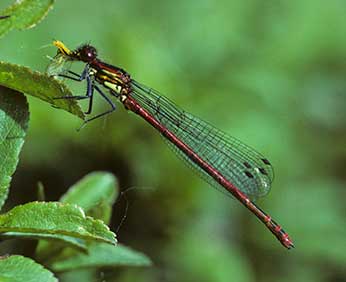Large Red Damselfly (Pyrrhosoma nymphula)
When: Late April to mid-September
How many: Relatively abundant

item held firmly in the mouth
As the first dragonfly or damselfly species to be seen each year, Large Red Damselflies are welcome harbingers of spring. They can often be seen in late April, whilst rapidly dwindling numbers of late flyers are sometimes present until mid or even late September.
The size suggested by their name is, however, relative, for although quite robust creatures, they are comparatively small - wingspan is a modest 4.5 centimetres, or so, whilst length is little more than 3.5 centimetres.
Bronze-black markings towards the end of the abdomen differentiate Large Red Damselflies from superficially similar small red damselfly males, which possess wholly red abdomens. Male and female Large Red Damselflies are similarly marked.
Common and widespread throughout the New Forest and, indeed, throughout much of Britain wherever suitable habitat exists, Large Red Damselflies are gregarious creatures that often tolerate the company of others of the same species at the same, sometimes small, pond.
References:
A Guide to the Dragonflies of Great Britain: Dan Powell
Dragonflies and Damselflies of Britain and Northern Europe: Bob Gibbons
The Dragonflies of Hampshire - John Taverner, Steve Cham, Alan Hold, et al
More links
Other related links
Search this site

Sadly, 58 animals were killed - 35 ponies, 13 cows, 8 donkeys and 2 sheep, whilst a further 32 were injured - 3 pigs, 9 donkeys, 11 cows and 9 ponies.
(Forty-three accidents occurred in daylight, 15 at twilight and 101 in the dark. Twenty-seven accidents were not reported by the driver involved).
Here's just one horrific example - Three donkeys killed in collision with van at notorious New Forest blackspot (Advertiser and Times)

